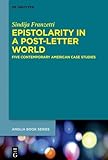Epistolarity in a Post-Letter World : Five Contemporary American Case Studies / Sindija Franzetti.
Material type: TextSeries: Buchreihe der Anglia / Anglia Book Series ; 83Publisher: Berlin ; Boston : De Gruyter, [2024]Copyright date: 2025Description: 1 online resource (XI, 148 p.)Content type:
TextSeries: Buchreihe der Anglia / Anglia Book Series ; 83Publisher: Berlin ; Boston : De Gruyter, [2024]Copyright date: 2025Description: 1 online resource (XI, 148 p.)Content type: - 9783111155081
- 9783111158389
- 9783111157375
- online - DeGruyter
- Issued also in print.
| Item type | Current library | Call number | URL | Status | Notes | Barcode | |
|---|---|---|---|---|---|---|---|
 eBook
eBook
|
Biblioteca "Angelicum" Pont. Univ. S.Tommaso d'Aquino Nuvola online | online - DeGruyter (Browse shelf(Opens below)) | Online access | Not for loan (Accesso limitato) | Accesso per gli utenti autorizzati / Access for authorized users | (dgr)9783111157375 |
Browsing Biblioteca "Angelicum" Pont. Univ. S.Tommaso d'Aquino shelves, Shelving location: Nuvola online Close shelf browser (Hides shelf browser)

|

|

|

|

|

|

|
||
| online - DeGruyter Haywood: Certain Island. 1, Memoirs of a Certain Island Adjacent to the Kingdom of Utopia / | online - DeGruyter Nietzsches Naturen / | online - DeGruyter Die Kathedrale im globalen Christentum : Konfessionsgeschichte, Kultur und Architektur / | online - DeGruyter Epistolarity in a Post-Letter World : Five Contemporary American Case Studies / | online - DeGruyter Beyond the Timeline: Resetting Historiography / | online - DeGruyter Personifikationen als ästhetische Reflexionsfiguren : Studien zu Sangspruch und Totenklagen / | online - DeGruyter Constructions with Lexical Repetitions in East Slavic / |
Frontmatter -- Acknowledgements -- Contents -- List of Illustrations -- Introduction -- Chapter One The Epistolary Novel and Epistolarity -- Chapter Two The Post-Letter World -- Chapter Three Re(dis)covering Epistolarity with Nick Bantock’s Griffin & Sabine Series -- Chapter Four Communion Through Letters in Gordon Lish’s Epigraph -- Chapter Five A World Without Letters: The Case of Mark Dunn’s Ella Minnow Pea -- Chapter Six A Father’s Letter to the Future: Epistolarity as a Legacy in Marilynne Robinson’s Gilead -- Chapter Seven “This Notebook, Your Letter”: The Future Reader and the Pivotal Present in Louise Erdrich’s Future Home of the Living God -- Coda -- Works Cited -- Index
restricted access online access with authorization star
http://purl.org/coar/access_right/c_16ec
The study intervenes in a field hitherto dominated by formal and historical analyses of the literary letter. Across the five case studies, the method of reading epistolarity as a motif is applied to a selection of American novels published after 1990: Nick Bantock’s Griffin & Sabine series (1991-2016), Gordon Lish’s Epigraph (1996), Mark Dunn’s Ella Minnow Pea (2001), Marilynne Robinson’s Gilead (2004), and Louise Erdrich’s Future Home of the Living God (2017). The texts encompass considerable formal and thematic variations: Bantock seeks a return to the literary letter; Lish and Dunn test the limitations of letters for conveying individual experience to a distant other; Robinson and Erdrich envision epistolarity as an address to a future. Exploring the employment of epistolarity as a motif, the study offers an interpretation of the messages these fictions extend for readers in a post-letter world. Communication technologies and practices may change, but epistolarity as a motif - a reprise of a scene of encounter that depends on keeping a distance between addresser and addressee – remains a deeply compelling site of inquiry in twenty-first-century literature.
Issued also in print.
Mode of access: Internet via World Wide Web.
In English.
Description based on online resource; title from PDF title page (publisher's Web site, viewed 20. Nov 2024)


